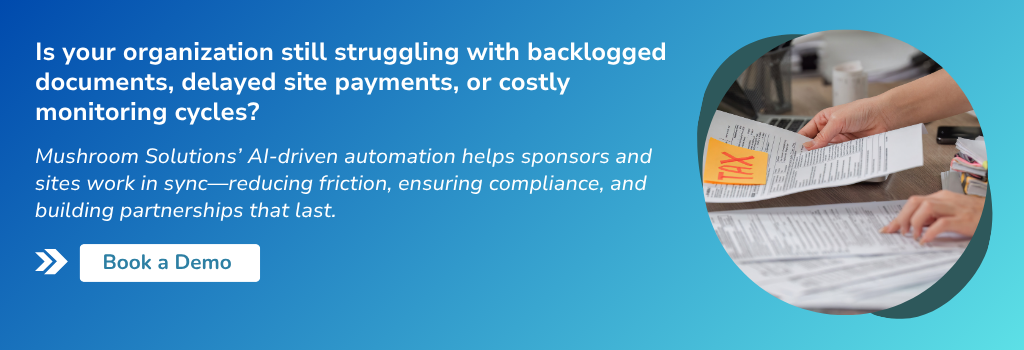Bridging the Gap: AI Tools That Reduce Sponsor–Site Friction
The success of a clinical trial often hinges on sponsors and sites coordination. Three areas in particular account for the bulk of sponsor-site tension: regulatory documentation, payments, and monitoring. These tasks, while necessary, have historically been manual, repetitive, and prone to errors. For sites, they represent a heavy administrative burden. For sponsors, they mean higher costs and slower timelines.
Artificial Intelligence (AI) is changing this dynamic. By automating routine but critical workflows, AI is bridging the gap between sponsors and sites—improving efficiency, transparency, and trust at the trial margin.
The Source of Friction in Sponsor–Site Relationships
To understand where AI delivers value, it helps to look at the everyday pain points that create friction:
- Regulatory Documentation: Sites often face shifting document requirements, manual QC steps, and version mismatches across platforms. Even minor errors can cause compliance delays.
- Payments: Slow reimbursement cycles and invoice disputes are consistently cited as a leading cause of site dissatisfaction. Manual reconciliation compounds delays and erodes trust.
- Monitoring: Traditional monitoring relies heavily on manual data checks and frequent site visits. The result: site fatigue, duplicated queries, and ballooning sponsor budgets.
Individually, each issue may seem manageable. Collectively, they add up to delays, increased costs, and strained sponsor-site partnerships—the very margins where trials succeed or fail.
Automating Regulatory Documentation
Pain Points
Existing regulatory paperwork is inefficient. Sites juggle multiple systems, manually re-enter data, and manage document version control under pressure. Quality control checks are slow, and errors can lead to rejected submissions or audit findings.
AI Solutions
- Intelligent Document Parsing & Auto-Tagging: Machine learning models can read, classify, and index regulatory documents into an electronic trial master file (eTMF) without human input.
- NLP-Driven Checklists: Natural language processing scans through paperwork and ensures submissions meet regulatory requirements before they are filed.
- Real-Time Submission Validation: AI-powered bots catch missing data points or non-compliance risks instantly, reducing costly rework.
Benefits
- Faster approvals and smoother audits.
- Reduced compliance risk across geographies.
- Less administrative burden on sites, freeing staff for patient-facing tasks.
AI as major submission content writer cuts quality control issues by half and improves cost efficiency by 50%.
Streamlining Payments with AI
Pain Points
Common financial frictions that cause sites hesitate to participate in—or drop out of—sponsored studies include:
- Complex, milestone-based invoicing that requires manual reconciliation.
- Payments delayed by weeks or months.
- Limited visibility into when and how reimbursements will arrive.
AI Solutions
- Automated Payment Triggers: AI systems link reimbursements to electronic trial milestones, eliminating the need for manual validation.
- Predictive Scheduling: Algorithms forecast payment timelines, giving sites clarity on when funds will hit their accounts.
- Anomaly Detection: AI can spot invoicing errors before they result in disputes, improving accuracy and transparency.
Benefits
- On-time payments improve site satisfaction and encourage long-term partnerships.
- Reduced financial disputes streamline trial operations.
- Transparency builds trust between sites and sponsors.
AI-enabled payment engines have been shown to reduce reconciliation cycles by 40%, addressing one of the most persistent complaints sites raise about sponsors.
Enhancing Monitoring through AI
Pain Points
Traditional monitoring methods rely heavily on on-site visits, manual source data verification, and repetitive queries. Sites often feel overwhelmed, while sponsors struggle with ballooning budgets and lagging data oversight.
AI Solutions
- Risk-Based Quality Management (RBQM): Machine learning models flag high-risk sites and data points for focused attention, reducing unnecessary checks.
- Automated Query Resolution: NLP tools can analyze data discrepancies and suggest resolutions, reducing redundant sponsor queries.
- Machine Vision for Source Data Verification: AI-powered optical character recognition (OCR) and pattern matching automates data validation against source documents.
Benefits
- Fewer site visits, reducing operational costs.
- Improved oversight, with real-time data risk alerts.
- Reduced site burden, as AI filters out unnecessary or duplicate queries.
AI-integrated trial monitoring and patient recruitment can reduce clinical development timelines by 6–12 months, representing up to a 40% acceleration for certain processes.
Conclusion
At the trial margin, small inefficiencies add up quickly. A missed regulatory check here, a delayed payment there, or an extra monitoring visit may seem minor—but across hundreds of sites and thousands of patients, these inefficiencies multiply into months of delay and millions in added costs.
AI provides a powerful way to reduce that friction. By automating regulatory documentation, streamlining payments, and enhancing monitoring, AI doesn’t just improve processes—it improves relationships. And in clinical research, stronger sponsor-site partnerships translate into faster, more compliant, and more successful trials.


